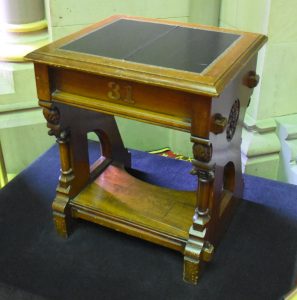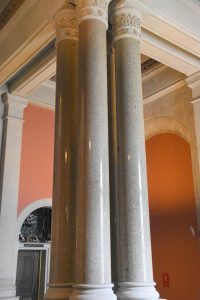Albany is one of the oldest surviving settlements of the original British thirteen colonies, and is the longest continuously chartered city in the United States. However, Kingston, 59 miles south of Albany was considered safer, became the capital city of New York. During the American Revolutionary War, British troops moving towards Albany and Kingston were stopped at Saratoga but on October 13, 1777, they made their way to Kingston. After the Revolution, Albany became the capital of New York in 1797 following formation of the United States.
New York's State House can only be described as impressive. Its mix of French and Italian Renaissance, Gothic and Romanesque styles reflect the influences of five architects over its 32 years of construction and a total cost of $25 million. It was dedicated in 1899 by Theodore Roosevelt.
On March 29, 1911, the fire broke out at 2:15 a.m. in the third floor Assembly Library of the New York State Capitol Building.
It quickly spread through the corridor to the State Library. Flames burst through third floor windows on the western side. With books and wooden shelving adding fuel, the fire shot up the Great Western or "Million Dollar" Staircase to the fourth floor and the two towers.
The one casualty of the fire
With over an hour before the next guided tour, we decided to see the adjacent Nelson A. Rockefeller Empire State Plaza. The 98-acre Plaza complex is centered around a huge pool
and framed by many spectacular state buildings and dramatic architectual lines.
The "Egg", center for preforming arts
Many statues, monuments and pieces of art are found throughout the center. It also hosts year-round events, a museum, farmer’s markets, shops, theatres, fine art, and much more.
Several panels (on both sides) contain the names of all of New York's men and women who died in Vietnam
 New York Correction and Parole Officers Memorial
New York Correction and Parole Officers Memorial
 New York Women Veterans Memorial
New York Women Veterans Memorial
New York Police Memorial
New York Firefighters Memorial
911 Memorial
Eternal Flame
Local Kindergarten children playing among one of the pieces of contemporary art found throughout the plaza
With some time still before our tour, we visited a State House exhibit entitled "1969" … a year we remember well
Wandering the Capital's first floor is like walking through a museum.
Entrance Foyer
George Washington
Christopher Columbus
Plaque marking the locaiton where President Ulysses S. Grant's body lay in state
Marques De LaFayetter
Hudson River Chain Links – each measssuring almost one foot in length
It was stretched across the Hudson River betwen West Point and Constitution Island to prevent British Vessels from navigating up the Hudson River during the American Revolution. West Point was a strategic location as the "S" curve in the river forced ships to slow down and become easy targets for shore-based gun batteries.
Ornate elevator facades
Multi-colored marble wainscoat panels
The Staircases
Lavishly carved in a variety of stone and crowned with magnificent skylights, the staircases are three of the most admired features of the Capitol.
Assembly Staricase – The Gothic-style Assembly Staaircase was completed in 1879, the first of the Capitol's three major staircases to be used. The staircase is built of sandstone and granite and is Moorish and Gothic in style. In 1949 the skyight was removed. However, in 1929 the skylight and lower laylight were restored, iluminating the staircase in natural light as originally intended. The new laylight includes images of New York State animals and plants, including turkeys, bats, whales, apples, sunflowers and grapes.
Senate Staaricase – The Senate Staircase, sometimes called the Evolutionary Staircase becase of the animal carvings that decorate it evolve from simple to complex as the stairs rise. When built, it was once hailed as "a great monumental work beleived to be without parallel on the face of the globe." In 1946, the skylike and laylight were removed to create additional office space. During the 2012 restoration of the Senate Staircase, the skylight and laylight were reconstructed.
Great Western Staircase – The Great Western Staircase, also known as the Million Dollar Staircase, took an unheard of 14 years to construct, from 1883-1897 and cost, more than one million dollars. The delays in constructing this magnificent staircase were two-fold. The staircase contains 444 steps and reaches 119 feet high, is renowned as an outstanding example of American architectural stone carving excellence.
Over 500 stone cutters and carvers were employed at various times. Many were Europeans who had mastered their trade in their homelands of England, Scotland and Italy. Their main task was the carving of various prominent people into the stone as ordered by chief architect Isaac Perry. He wanted 77 in all. What's remarkable is these 77 faces, along with countless other designs, were sculptured from existing stone walls.
Using only ladders and scaffolding, often in very uncomfortable positions, these stone artists spent years, at a salary of five dollars a day, sculpturing some of the finest stonework found anywhere in the world.
Among the 77 famous faces beautifully carved into the sandstone staircases are such famous Americans as Washington, Lincoln, Grant, and Susan B. Anthony – each etched with astonishingly fine detail. With the stone gallery of prominent Americans out of the way, The architect also decided to allow his elite group of carvers to sculpt the faces of friends, relatives, and people seen on the streets.
Flag Room
The Capitol Flag Room is a memorial to the loss of life given in the defense of freedom. On display is part of the nearly 1,000 battle flags that date from the War of 1812 through the Gulf War. Over half of the flags are from the Civil War, where New York regiments fought in many of the great battles. Also here are regiment flags that marched with Teddy Roosevelt in Cuba at the "Battle of San Juan Hill" and with troops in the Philippines during the Spanish-American War. Finally, there are flags from both World War I and II. Those were the last wars in which regiments were formed with soldiers that were all from the same state.
Nearby is the "Victory Eagle" sculpture
Senate Chamber
in order to fully appreciate the interior splendor of the Capitol building, you need only to look at the Senate Chamber. It was first occupied in 1881.
Beginning at its highest point, the chamber's richly carved golden oak ceiling was designed with deep paneled "pockets" or recesses, creating an acoustically perfect "debate arena" for the senators.
The upper walls are covered with beautiful, shimmering 23 carat gold leaf.
A master at using the different materials of the world, The architect imported Siena marble from Italy for the large arches above the visitor's gallery, red granite from Scotland for the pillars, and Mexican onyx to panel the north and south walls. The ultimate in luxury was attained with red leather and carved mahogany paneling on the walls below the galleries.
At the front of the chamber sits the Senate's chief presiding officer. Seated on the top tier of the dais, he is flanked by an aide and the Senate Chaplain. Every legislative session begins with a prayer and the Pledge of Allegiance. The bottom tier is for the various Senate staff who track legislation and keep attendance.
At the back of the chamber are two large fireplaces, each with openings six feet high.
Designed initially as sources of heat, they soon became mere decoration when electricity became a standard feature of the completed building. However, building on a tradition that began with the English parliament, the fireplaces were soon serving as quiet meeting areas for senators to "walk into", and discuss important issues, And, because the chamber's acoustics allowed for virtually every spoken word to be heard, these "fireplace" chats soon became an everyday occurrence.
For all of the amazing carvings, if you look closely, you will find where the money ran out and the ornate sculpting stopped
There is a grandfather's clock in one corner has been located there since the capitol first opened and survived the 1911 fire. Hallway outside Senate Chamber
Hallway outside Senate Chamber
Assmebly Chamber
The original Assembly chamber was designed in a Moorish Gothic style and characterized by the period's architectural critic, Henry Van Brunt, as "the most monumental interior in the country".
The massive volume was marked by a groined vaulted sandstone ceiling that rose to a height of 56 feet above the floor. At the time of its construction, the chamber's ceiling was the widest vaulted structure attempted to that time. The sandstone was ornamented with bands painted in tones of greenish-blue, red and black, and highlighted with gold. Supporting the spectacular groined arches were four pillars of polished granite.
On the north and south walls, large windows of both clear and stained glass provided natural light. Even the chamber's furniture was specially designed for the room. Made of solid mahogany and red leather, it provided the perfect accent for a noble setting. Unfortunately, almost from the start the arched chamber ceiling experienced structural problems.
 As the foundation in the Capitol began to settle the stone ceiling began to crack and break.
As the foundation in the Capitol began to settle the stone ceiling began to crack and break.
Soon, members were greeted each morning with desks covered in dust and pieces of stone. Finally, when a large rock, the size of a bowling ball, fell dangerously close to an assemblyman, it was decided that something must be done. That something was a new ceiling, which replaced the original vaulted ceiling at a height four feet below the ceiling's beautiful murals. Today's Assembly chamber, while still an impressive room, only slightly resembles the magnificent wonder that was first opened in 1879.
 Original Representative's desk dating from 1899
Original Representative's desk dating from 1899
Hallway outside Assembly Chamber
Doorway to Lieutenant Governor's Office
Robert Livingstone – Architect of the State House
Reception or War Room
Hall of Governors
The protraits for all of New York's 58 governors hang along the State House hallways. These include four presidents, including Teddy and Franklin Roosevelt, Martin Van Buren,
 three Vice Presidents (George Clinton, Daniel Tompkins, and Nelson Rockerfeller), the nationa's first Chief Justice of the Supreme Court, John Jay,
three Vice Presidents (George Clinton, Daniel Tompkins, and Nelson Rockerfeller), the nationa's first Chief Justice of the Supreme Court, John Jay,
 and the Seretary of State who negotiated "Seward's Folly", the purcahse of Alaska, William Seward.
and the Seretary of State who negotiated "Seward's Folly", the purcahse of Alaska, William Seward.
A variety of paintings hang throughout the building.
New York City – Junction of the Bowery and Broadway (circa 1828)
The SS Calhoun – the "Long Island Ferry" of the1820s
On display in one of the first floor hallways are images of the painted panels fabricated for the 2012 Restoration of the Capitol’s Assembly Staircase laylight. The hand-blown colored glass panels show interpretations of select New York State flora and fauna. The artists fabricated the panels and painted twenty native fauna (trout, Atlantic sturgeon, toad, beaver, turtle snake, dragonfly, bluebird, woodpecker, raven, owl hawk, wild turkey, blue heron, bat, rabbit, gray wolf, black bear and whale) and four native flora (rose, grapes, black-eyed susan and apples).
The only remaing remnant from the state's first Capitol is its Cornerstone.
Architecturally, New York's State Capitol is one of the most amazing.






























































































 ]
]





 \
\





















